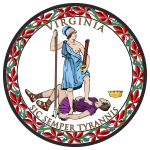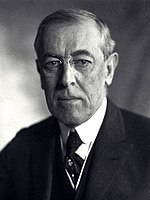| ||||||||||||||||||||||||||
| ||||||||||||||||||||||||||
 County Results
| ||||||||||||||||||||||||||
| ||||||||||||||||||||||||||
The 1916 United States presidential election in Virginia took place on November 7, 1916. Voters chose 12 representatives, or electors to the Electoral College, who voted for president and vice president.
The 1900s had seen Virginia, like all former Confederate States, almost completely disenfranchise its black and poor white populations through the use of a cumulative poll tax and literacy tests.[1] So severe was the disenfranchising effect of the new 1902 Constitution that the electorate for the 1904 presidential election was halved compared to that of previous elections, and it has been calculated that a third of those who voted were state employees and officeholders.[1]
This limited electorate meant Virginian politics was controlled by political machines based in Southside Virginia — firstly one led by Thomas Staples Martin and after he died the Byrd Organization. Progressive “antiorganization” factions were rendered impotent by the inability of almost all of their potential electorate to vote.[2] Unlike the Deep South, historical fusion with the “Readjuster” Democrats,[3] defection of substantial proportions of the Northeast-aligned white electorate of the Shenandoah Valley and Southwest Virginia over free silver,[4] and an early move towards a “lily white” Jim Crow party[3] meant that in general elections the Republicans retained around one-third of the small statewide electorate,[5] with the majority of GOP support located in the western part of the state. However, in many parts of the state — like in Tennessee during the same period — the parties avoided competition by an agreed division over local offices.[2]
Unlike in 1908, neither major party campaigned in the state — which had voted Democratic in every election since 1876 — during the fall. A straw ballot taken early in September saw Democratic nominee and incumbent President Woodrow Wilson gaining seventy-nine votes to the Republican nominee, former U.S. Supreme Court Justice Charles E. Hughes’ six.[6] Later straw polls in October did not even include the state, and ultimate Virginia voted for Wilson by a slightly greater majority than he had won four years previously. Wilson ultimately won the national election with 49.24 percent of the vote.
| Elections in Virginia |
|---|
 |
- ^ a b Kousser, J. Morgan (1974). The Shaping of Southern Politics: Suffrage Restriction and the Establishment of the One-Party South, 1880-1910. Yale University Press. pp. 178–181. ISBN 0-300-01696-4.
- ^ a b Key, Valdimer Orlando (1949). Southern Politics in State and Nation. pp. 20–25.
- ^ a b Heersink, Boris; Jenkins, Jeffrey A. (March 19, 2020). Republican Party Politics and the American South, 1865-1968. Cambridge University Press. pp. 217–221. ISBN 978-1107158436.
- ^ Moger, Allen. "The Rift in Virginia Democracy in 1896". The Journal of Southern History. 4 (3): 295–317. doi:10.2307/2191291. JSTOR 2191291.
- ^ Phillips, Kevin P.; The Emerging Republican Majority, pp. 210, 242 ISBN 978-0-691-16324-6
- ^ "Will Win Without Vote of Solid South". The Carson City Daily Appeal. Carson City, Nevada. September 6, 1916. p. 2.

